Productivity: More with Less by Better
Available resources are scarce. To sustain our society's income and living standards in a world with ecological and demographic change, we need to make smarter use of them.
Dossier

In a nutshell
Nobel Prize winners Paul Samuelson and William Nordhaus state in their classic economics textbook: Economics matters because resources are scarce. Indeed, productivity research is at the very heart of economics as it describes the efficiency with which these scarce resources are transformed into goods and services and, hence, into social wealth. If the consumption of resources is to be reduced, e. g., due to ecological reasons, our society’s present material living standards can only be maintained by productivity growth. The aging of our society and the induced scarcity of labour is a major future challenge. Without productivity growth a solution is hard to imagine. To understand the processes triggering productivity growth, a look at micro data on the level of individual firms or establishments is indispensable.
Our experts

Department Head
If you have any further questions please contact me.
+49 345 7753-708 Request per E-Mail
President
If you have any further questions please contact me.
+49 345 7753-700 Request per E-MailAll experts, press releases, publications and events on “Productivity”
Productivity is output in relation to input. While the concept of total factor productivity describes how efficiently labour, machinery, and all combined inputs are used, labour productivity describes value added (Gross Domestic Product, GDP) per worker and measures, in a macroeconomic sense, income per worker.
Productivity Growth on the Slowdown
Surprisingly, despite of massive use of technology and rushing digitisation, advances in productivity have been slowing down during the last decades. Labour productivity growth used to be much higher in the 1960s and 1970s than it is now. For the G7 countries, for example, annual growth rates of GDP per hour worked declined from about 4% in the early 1970s to about 2% in the 1980s and 1990s and then even fell to about 1% after 2010 (see figure 1).
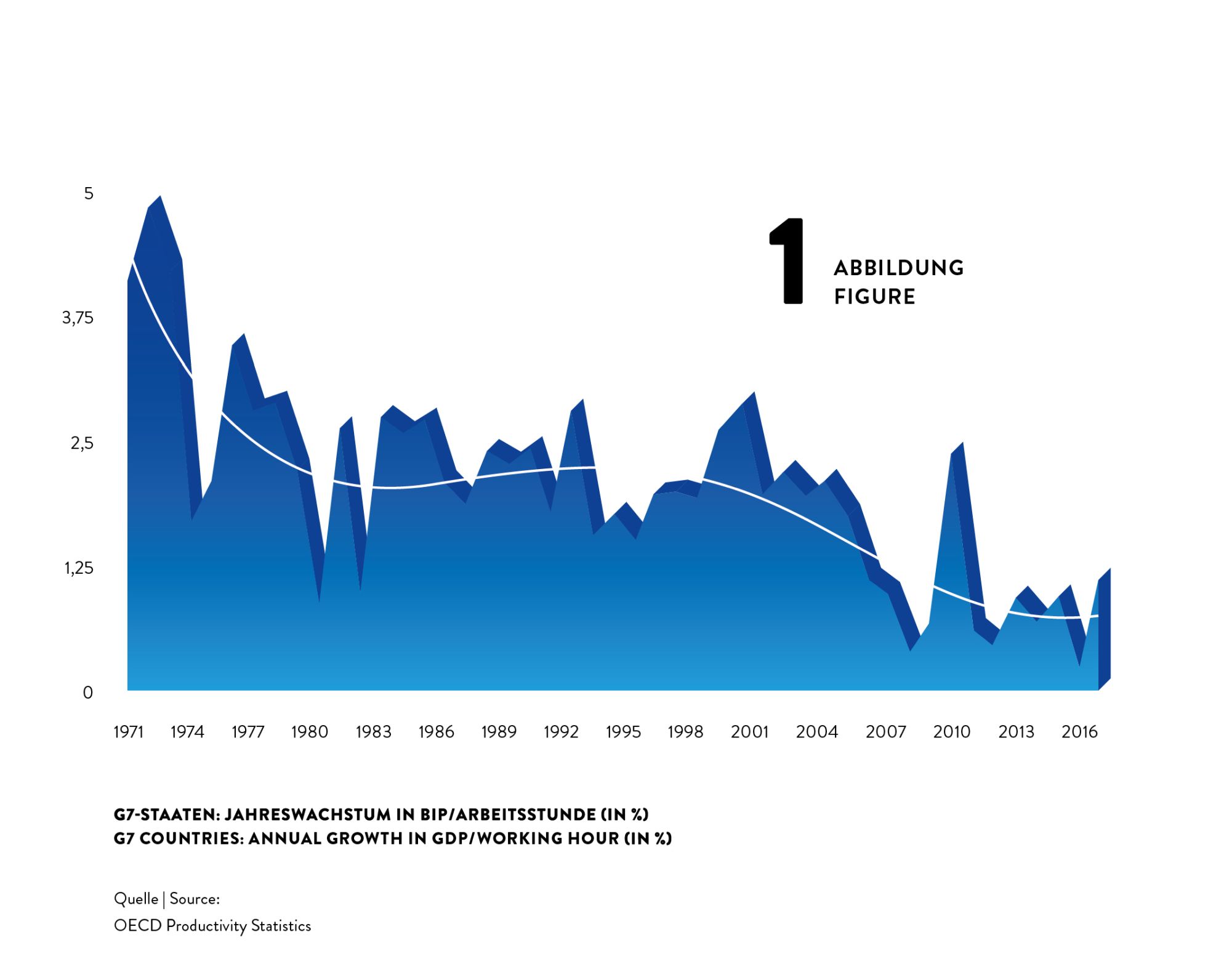
This implies a dramatic loss in potential income: Would the 4% productivity growth have been sustained over the four and a half decades from 1972 to 2017, G7 countries’ GDP per hour would now be unimaginable 2.5 times as high as it actually is. What a potential to, for instance, reduce poverty or to fund research on fundamentals topics as curing cancer or using fusion power!
So why has productivity growth declined dramatically although at the same time we see, for instance, a boom in new digital technologies that can be expected to increase productivity growth? For sure, part of the decline might be spurious and caused by mismeasurement of the contributions of digital technologies. For instance, it is inherently difficult to measure the value of a google search or another video on youtube. That being said, most observers agree that part of the slowdown is real.
Techno-Pessimists and Techno-Optimists
Techno-pessimists say, well, these new technologies are just not as consequential for productivity as, for instance, electrification or combustion engines have been. Techno-optimists argue that it can take many years until productivity effects of new technologies kick in, and it can come in multiple waves. New technology we have now may just be the tools to invent even more consequential innovations in the future.
While this strand of the discussion is concerned with the type of technology invented, others see the problem in that inventions nowadays may diffuse slowly from technological leaders to laggards creating a wedge between few superstar firms and the crowd (Akcigit et al., 2021). Increased market concentration and market power by superstar firms may reduce competitive pressure and the incentives to innovate.
Finally, reduced Schumpeterian business dynamism, i.e. a reduction in firm entry and exit as well as firm growth and decline, reflects a slowdown in the speed with which production factors are recombined to find their most productive match.
While the explanation for and the way out of the productivity puzzle are still unknown, it seems understood that using granular firm level data is the most promising path to find answers.
What are the Origins of Productivity Growth?
Aggregate productivity growth can originate from (i) a more efficient use of available inputs at the firm level as described above or (ii) from an improved allocation of resources between firms.
Higher efficiency at the firm level captures, e.g., the impact of innovations (Acemoglu et al., 2018) or improved firm organisation (management) (Heinz et al., 2020; Müller und Stegmaier, 2017), while improved factor allocation describes the degree of which scarce input factors are re-allocated from inefficient to efficient firms (‘Schumpeterian creative destruction’) (Aghion et al., 2015; Decker et al., 2021).
Most economic processes influence the productivity of existing firms and the growth and the use of resources of these firms and their competitors as well. The accelerated implementation of robotics in German plants (Deng et al., 2020), the foreign trade shocks induced by the rise of the Chinese economy (Bräuer et al., 2019), but also the COVID-19 pandemic, whose consequences are still to evaluate (Müller, 2021) not only effects on productivity and growth of the firms directly affected but at the same time may create new businesses and question existing firms.
While productivity can be measured at the level of aggregated sectors or economies, micro data on the level of individual firms or establishments are indispensable to study firm organisation, technology and innovation diffusion, superstar firms, market power, factor allocation and Schumpeterian business dynamism. The IWH adopts this micro approach within the EU Horizon 2020 project MICROPROD as well as with the CompNet research network.
As “creative destruction” may also negatively affect the persons involved (e. g., in the case of layoffs, Fackler et al., 2021), the IWH analyses the consequences of bankruptcies in its Bankruptcy Research Unit and looks at the implications of creative destruction for the society, e. g., within a project funded by Volkswagen Foundation searching for the economic origins of populism and in the framework of the Institute for Research on Social Cohesion.
Publications on “Productivity”
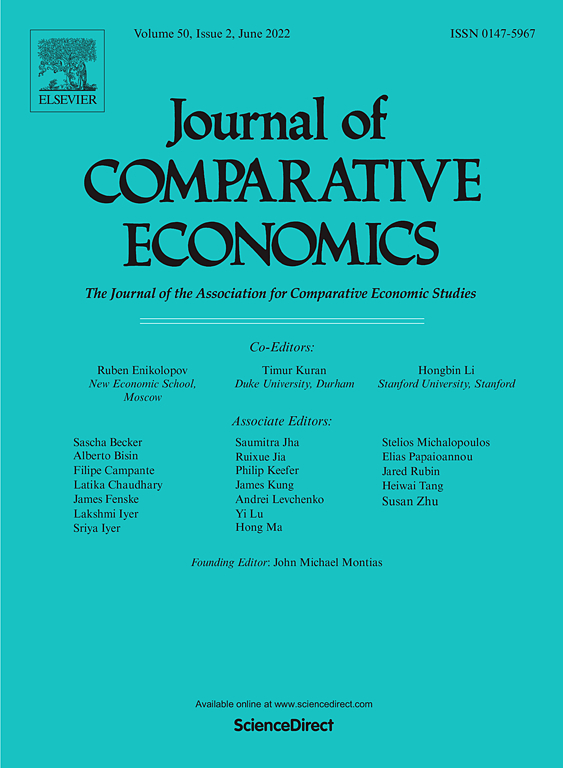
The East-West German Gap in Revenue Productivity: Just a Tale of Output Prices?
in: Journal of Comparative Economics, No. 3, 2022
Abstract
East German manufacturers’ revenue productivity is substantially below West German levels, even three decades after German unification. Using firm-product-level data with product quantities and prices, we analyze the role of product specialization and show that the prominent “extended work bench hypothesis” cannot explain these sustained productivity differences. Eastern firms specialize in simpler product varieties generating less consumer value and being manufactured with less or cheaper inputs. Yet, such specialization cannot explain the productivity gap because Eastern firms are physically less productive for given product prices. Hence, there is a genuine price-adjusted physical productivity disadvantage of Eastern compared to Western firms.
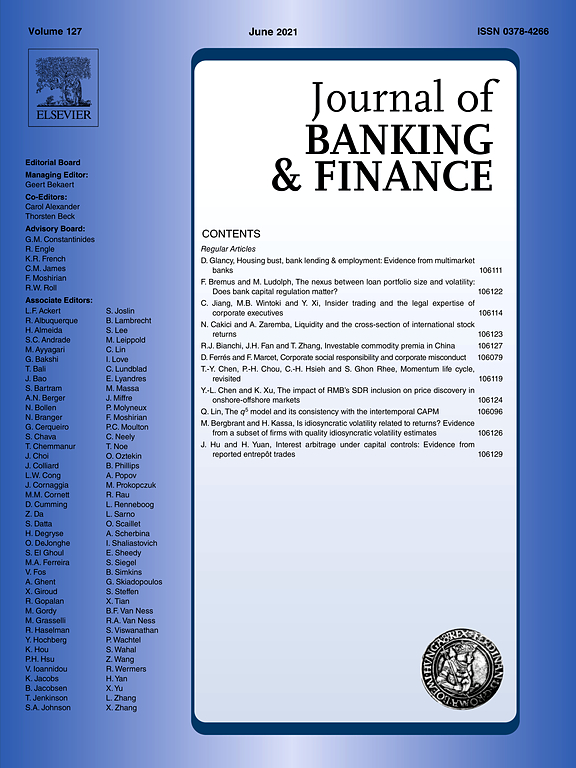
Productivity, Managers’ Social Connections and the Financial Crisis
in: Journal of Banking and Finance, August 2022
Abstract
This paper investigates whether managers’ personal connections help corporate productivity to recover after a negative economic shock. Leveraging the heterogeneity in the severity of the financial crisis across different sectors, the paper reports that (i) the financial crisis had a negative effect on within-firm productivity, (ii) the effect was long-lasting and persistent, supporting a productivity-hysteresis hypothesis, and (iii) managers’ personal connections allowed corporations to recover from this productivity slowdown. Among the possible mechanisms, we show that connected managers operating in affected sectors foster productivity recovery through higher input cost efficiency and better access to the credit market, as well as more efficient use of labour and capital.
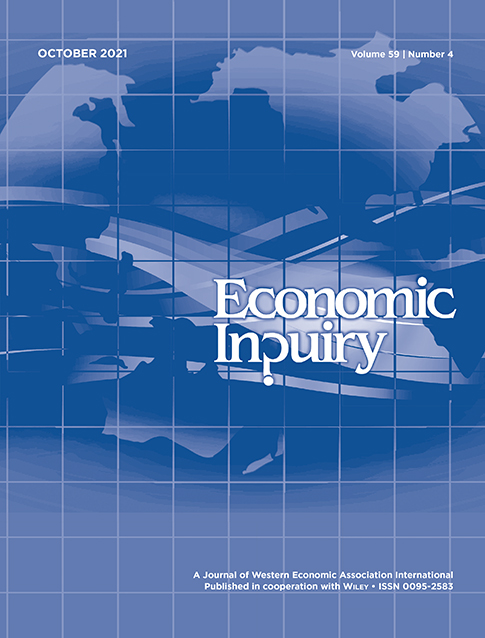
The Cleansing Effect of Banking Crises
in: Economic Inquiry, No. 3, 2022
Abstract
We assess the cleansing effects of the 2008–2009 financial crisis. U.S. regions with higher levels of supervisory forbearance on distressed banks see less restructuring in the real sector: fewer establishments, firms, and jobs are lost when more distressed banks remain in business. In these regions, the banking sector has been less healthy for several years after the crisis. Regions with less forbearance experience higher productivity growth after the crisis with more firm entries, job creation, and employment, wages, patents, and output growth. Forbearance is greater for state-chartered banks and in regions with weaker banking competition and more independent banks.

Projektion der wirtschaftlichen Entwicklung in den Bundesländern 2022 bis 2060
in: IWH Technical Reports, No. 1, 2022
Abstract
Die Entwicklung der wirtschaftlichen Leistungsfähigkeit in den Bundesländern wird in den kommenden Jahren vor allem durch das langfristige Produktivitätswachstum und die Verschiebung der Altersstruktur gekennzeichnet sein. Der Altenquotient, der das zahlenmäßige Verhältnis von Personen über 64 Jahren zu den Personen zwischen 15 und 64 Jahren abbildet, wird gemäß Bevölkerungsvorausberechnungen der Statistischen Ämter von gut 30% auf über 50% bis zum Jahr 2060 ansteigen. Allerdings unterscheiden sich Ausgangslage bei der Produktivität und Altersstruktur in den Bundesländern teilweise erheblich, sodass sich auch das Bruttoinlandsprodukt je Einwohner in den kommenden Jahren regional unterschiedlich entwickeln wird.
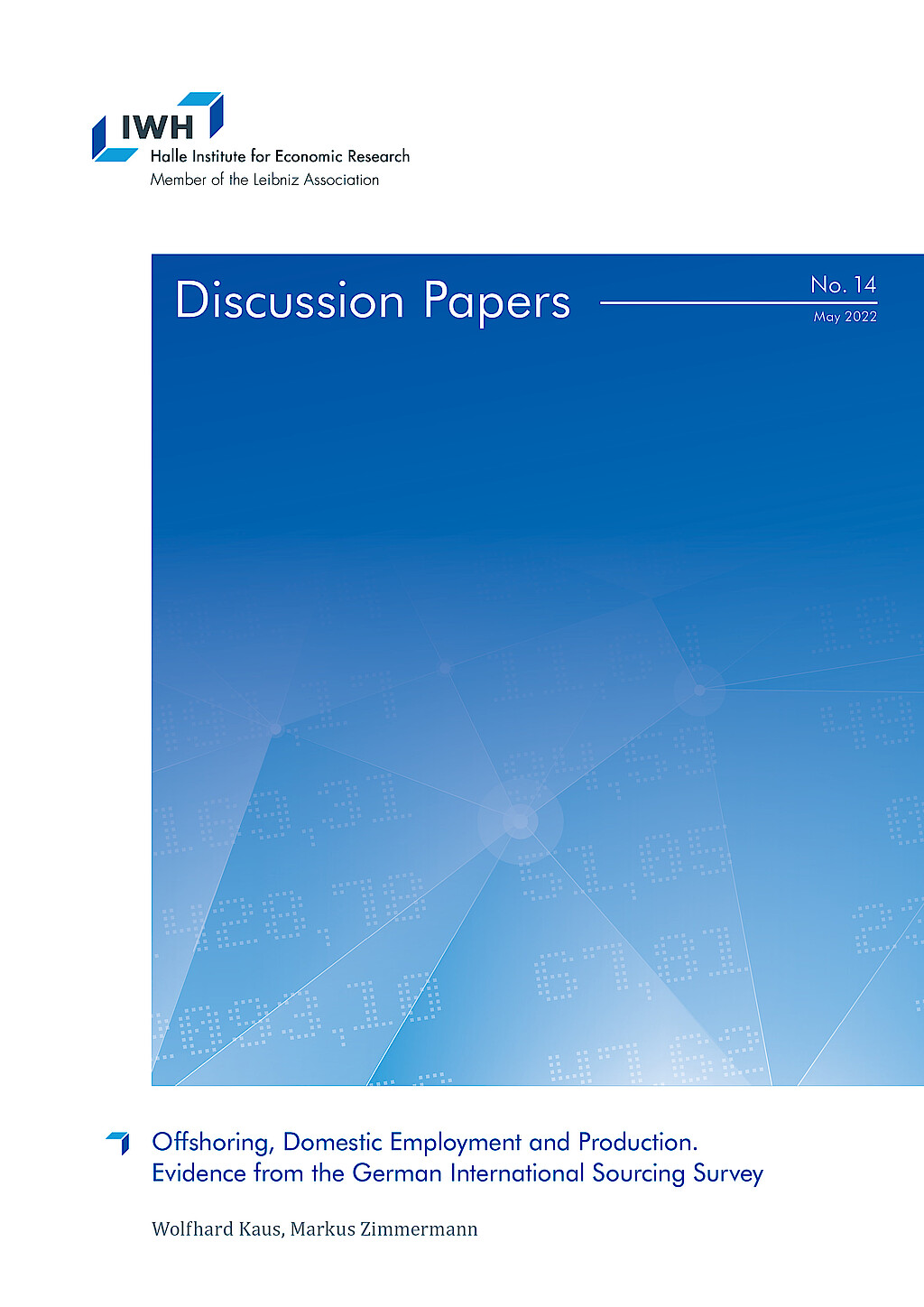
Offshoring, Domestic Employment and Production. Evidence from the German International Sourcing Survey
in: IWH Discussion Papers, No. 14, 2022
Abstract
This paper analyses the effect of offshoring (i.e., the relocation of activities previously performed in-house to foreign countries) on various firm outcomes (domestic employment, production, and productivity). It uses data from the International Sourcing Survey (ISS) 2017 for Germany, linked to other firm level data such as business register and ITGS data. First, we find that offshoring is a rare event: In the sample of firms with 50 or more persons employed, only about 3% of manufacturing firms and 1% of business service firms have performed offshoring in the period 2014-2016. Second, difference-in-differences propensity score matching estimates reveal a negative effect of offshoring on domestic employment and production. Most of this negative effect is not because the offshoring firms shrink, but rather because they don’t grow as fast as the non-offshoring firms. We further decompose the underlying employment dynamics by using direct survey evidence on how many jobs the firms destroyed/created due to offshoring. Moreover, we do not find an effect on labour productivity, since the negative effect on domestic employment and production are more or less of the same size. Third, the German data confirm previous findings for Denmark that offshoring is associated with an increase in the share of ‘produced goods imports’, i.e. offshoring firms increase their imports for the same goods they continue to produce domestically. In contrast, it is not the case that offshoring firms increase the share of intermediate goods imports (a commonly used proxy for offshoring), as defined by the BEC Rev. 5 classification.



